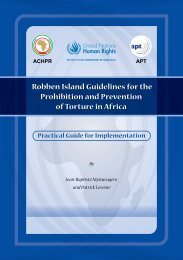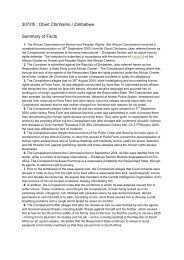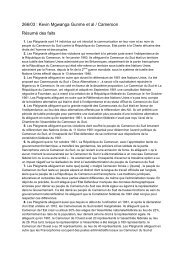English - African Commission on Human and Peoples' Rights
English - African Commission on Human and Peoples' Rights
English - African Commission on Human and Peoples' Rights
- No tags were found...
You also want an ePaper? Increase the reach of your titles
YUMPU automatically turns print PDFs into web optimized ePapers that Google loves.
also increased am<strong>on</strong>g children from the 1988 survey figures, although decreased slightlyam<strong>on</strong>g women, with the total goitre rate for school-going children at 42.5% <strong>and</strong> forwomen of child-bearing age at 36%. The prevalence of vitamin A deficiency as of 1993was 13.4%.According to the Health Sector Development Plan, major diseases, which c<strong>on</strong>tribute tohigh mortality am<strong>on</strong>g children, are acute respiratory infecti<strong>on</strong>s (AM), immunizati<strong>on</strong>preventablediseases <strong>and</strong> diarrhoea. Pneum<strong>on</strong>ia accounts for 70% of hospital admissi<strong>on</strong>sfor respiratory diseases for under <strong>on</strong>e-year-olds <strong>and</strong> about 60% of the over-<strong>on</strong>es.Diarrhoea hospital admissi<strong>on</strong> rates have increased dramatically am<strong>on</strong>g under-fives, in partdue to the drought <strong>and</strong> resulting poor water quality. The infant <strong>and</strong> child mortality ratesare 106 per 1,000, <strong>and</strong> 156 per 1,000 live births respectively.Five percent of hospital pediatric admissi<strong>on</strong>s are for TB cases in the under fourteen-yearold.Am<strong>on</strong>gst adult men <strong>and</strong> women, there has been a dramatic increase (40 per cent) isthe number of registered Tuberculosis (TB) cases between 1988 <strong>and</strong> 1992. Theprevalence of HIV associated TB is much higher am<strong>on</strong>g females (18 per cent) than males(10 per cent). Sexually-transmitted diseases (STD's), particularly HIV/AIDS, threatento increase child <strong>and</strong> maternal mortality trues as well as worsen household dependencyratios through the premature death of younu adults (Disease C<strong>on</strong>trol Unit - MOHSW1994).Community health promoti<strong>on</strong> has been improved through the training <strong>and</strong> deploymentof Community Health Workers (CHWs). Community partnership in health servicefinancing <strong>and</strong> income generati<strong>on</strong> for food security have been improved in eight healthservice areas (HSA) through the Bamako Initiative (BI).The Government of Lesotho has adopted primary health care (PHC) as its strategy forhealth development in the country. "The Health <strong>and</strong> Social Welfare Sector DevelopmentPlan, 1995/96 - 1999/2000" emphasizes improving access to health services - particularlyfor geographically hard-to reach communities, disparity reducti<strong>on</strong>, decentralizati<strong>on</strong>, costeffectiveinterventi<strong>on</strong>s, partnership with the community, <strong>and</strong> intersectoral collaborati<strong>on</strong>.On the basis of the informati<strong>on</strong> currently available areas identified as c<strong>on</strong>tributingsignificantly to morbidity <strong>and</strong> mortality in the country, <strong>and</strong> therefore ofpriority for acti<strong>on</strong>,include TB, STD's, <strong>and</strong> HIV/AIDS, pregnancy-related c<strong>on</strong>diti<strong>on</strong>s, diarrhoea, AcuteRespiratory Infecti<strong>on</strong> (ARI), measles <strong>and</strong> malnutriti<strong>on</strong>. These areas, which can begrouped into the broad categories of maternal health, child health. t eproductive health <strong>and</strong>nutriti<strong>on</strong>, will be the focus of the 1997-2001 UNICEF/GOL pi oLrarnme of cooperati<strong>on</strong>.The 1993 internati<strong>on</strong>al evaluati<strong>on</strong> survey of Mother <strong>and</strong> Child Health (MCH) FamilyPlanning (FP) in Lesotho indicated a full immunisati<strong>on</strong> coverage rate of 71 per cent ofchildren under <strong>on</strong>e year of age. The majority of the reas<strong>on</strong>s given for children not being36
















